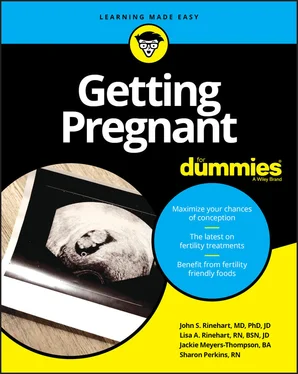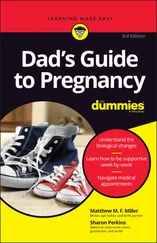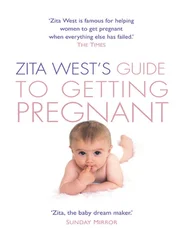1 ...8 9 10 12 13 14 ...29 The main female hormones are:
Estrogen (E2)
Luteinizing hormone (LH)
Follicle-stimulating hormone (FSH)
Progesterone (P4)
In Sync: How Female Reproductive Parts Work Together
All the components of your reproductive tract — the vagina, uterus, ovaries, fallopian tubes, and the glands that orchestrate your hormones — have to work together perfectly for you to be able to get pregnant. (Yes, you need sperm, too, but we get to that in a later section, “ Hanging Out with the Guys.”)
Although your menstrual cycle seems simple enough, a lot of things, unfortunately, can go wrong. We not only address how your cycle works but also how it may not work in the next few sections.
Taking a spin on the menstrual cycle
The hormone-secreting systems work to create your menstrual cycle like this:
1 Menstrual Phase: During menstruation, the old uterine lining breaks down and passes through the vagina as menstrual flow. This process takes three to seven days and is commonly called a “period.”
2 Follicular/Proliferative Phase: On Day 1 of bleeding, the pituitary gland, under influence from the hypothalamus, releases follicle-stimulating hormone (FSH) . The rising FSH levels cause the ovaries to rescue the 10 to 20 remaining follicles, called antral follicles, which begin to grow. The cells surrounding each egg secrete a liquid, forming a follicle, a fluid-filled sac. Each follicle contains one immature egg. During the follicular phase, one follicle continues to develop, and the others die. In the ovary, the one egg-containing follicle is growing (in response to FSH and luteinizing hormone (LH), which is also produced by the pituitary), and this growing follicle begins producing estrogen. The estrogen produced by the ovary causes the uterine lining to thicken or proliferate. This is called the proliferative phase of the uterus. The follicular phase and the proliferative phase occur in the first half of the menstrual cycle. One refers to what’s happening in the ovary (follicular phase), and the other refers to what’s happening in the uterus (proliferative phase).One follicle becomes dominant, growing faster than the others. As the dominant follicle grows, it produces more estrogen, which also increases the lining of the uterus. The amount of FSH released decreases, and the smaller follicles stop growing and are reabsorbed.A large amount of LH, called an LH surge, is released from the pituitary gland as the estrogen rises. This makes the egg inside the dominant follicle mature.
3 Ovulation: The follicleopens; the egg is released (ovulation) and is picked up by one of the fallopian tubes. If the egg is joined by sperm, it will continue to travel through the fallopian tube to the uterus. The uterine lining has now developed enough to support embryo implantation, and the endometrial glands of the uterine lining secrete proteins that help guide the embryo to the correct spot.
4 Luteal phase: The leftover part of the follicle, now called the corpus luteum, produces progesterone and some estrogen, which help an embryo implant. If you are not pregnant, the corpus luteum collapses, progesterone and estrogen levels decline, the uterine lining begins to break down, and menstruation begins roughly two weeks after ovulation.
Recognizing the importance of regular periods
Do your periods always come every 28 days like clockwork? If they do, you’re a rarity; only one in ten women fall into what we’ve been conditioned to think of as a “normal” menstrual pattern. Most women have cycles 25 to 31 days apart.
When your doctor asks you how long your cycles are, he’s asking how many days are between Day 1 of one period and Day 1 of the next period. When he asks how long your period is, he’s asking how many days you bleed. Day 1 of your period is the first day of normal (for you) flow, not the day when you have light or irregular spotting before your period starts.
 If you are on, or have been on, birth control pills, be sure to note that in charting your menstrual pattern. The pill chemically coordinates your cycle to come at the same time each month (provided you take the pill correctly!).
If you are on, or have been on, birth control pills, be sure to note that in charting your menstrual pattern. The pill chemically coordinates your cycle to come at the same time each month (provided you take the pill correctly!).
What’s regular for you may not be regular for someone else but having some sort of pattern to your periods is important because it indicates that you’re producing and releasing eggs on a regular basis. But just because a woman is having periods does not give us any further information about egg quality or whether her uterus can support a pregnancy.
 If your cycles are very long or very irregular, you may not be maturing eggs, you may not have sufficient hormone levels, or there may be other underlying medical issues. See the next section, “ Understanding the causes of malfunctioning menstrual cycles” for more on how irregular cycles affect your chance of getting pregnant.
If your cycles are very long or very irregular, you may not be maturing eggs, you may not have sufficient hormone levels, or there may be other underlying medical issues. See the next section, “ Understanding the causes of malfunctioning menstrual cycles” for more on how irregular cycles affect your chance of getting pregnant.
Understanding the causes of malfunctioning menstrual cycles
Although it may seem like your menstrual cycle runs like clockwork, always appearing on the expected day, the likelihood is that at least part of the time, your cycle is out of sync, showing up too early, too late, or not at all, even though you’re not pregnant. Irregular periods not only make it hard to determine when you ovulate, but they can also indicate that your reproductive system is in need of fine-tuning. In this section, we discuss all the ways cycles can get out of sync, what it can mean, and how your doctor may suggest fixing them.
Menstrual cycles that don’t fall into the norm can indicate that you’re not ovulating at all or that you’re only ovulating occasionally. An occasional irregular cycle can be brought about by stress; a change in routine, exercise, or eating patterns; or illness, but periods that are “never the same length twice,” consistently shorter than normal or longer than normal, should be evaluated by your doctor.
Bleeding too often — short cycles
If your cycles are very short — less than 25 days apart on a regular basis, you may be ovulating too soon. Since the period between ovulation and the start of your period should consistently be 14 days, if your periods are short, it usually (but not always — we discuss the alternative in this section) means that you have a short follicular phase, the time between your period and your ovulation.
A short follicular phase can mean that the egg is developing in the incorrect time frame. Short follicular phases can occur when your ovarian reserve, the number of eggs you still have in your ovaries, is starting to decrease. It occurs because there is an elevation of the FSH level in the previous cycle, which accelerates the development of the egg. So, a clinical pearl is that short cycles may raise red flags about reduced ovarian reserve. A woman who has traditionally had cycles ranging from 28–32 days and then notices that they have shortened to 26–27 days may be showing signs of reduced ovarian reserve. This is especially true if she is over the age of 35.
For quite some time, a lot of emphasis was placed on the second half of the cycle or the luteal phase. If this was shorter than ten days, a diagnosis of luteal phase defect was made and sometimes progesterone was used to try to correct for this. While there may be some controversy about this, recent understanding of how the cycle works has suggested that there may not be a luteal phase defect. The luteal phase is dependent upon the first half of the cycle, the follicular phase. The follicular phase is dependent upon the quality of the egg. So short luteal phases are a product of poor egg quality.
Читать дальше

 If you are on, or have been on, birth control pills, be sure to note that in charting your menstrual pattern. The pill chemically coordinates your cycle to come at the same time each month (provided you take the pill correctly!).
If you are on, or have been on, birth control pills, be sure to note that in charting your menstrual pattern. The pill chemically coordinates your cycle to come at the same time each month (provided you take the pill correctly!).










